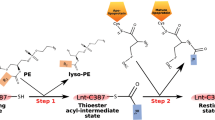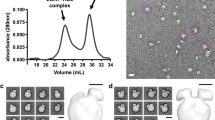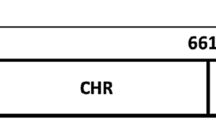Abstract
Exchangeable apolipoproteins can convert between lipid-free and lipid-associated states. The C-terminal domain of human apolipoprotein A-I (apoA-I) plays a role in both lipid binding and self-association. Site-directed spin-label electron paramagnetic resonance spectroscopy was used to examine the structure of the apoA-I C terminus in lipid-free and lipid-associated states. Nitroxide spin-labels positioned at defined locations throughout the C terminus were used to define discrete secondary structural elements. Magnetic interactions between probes localized at positions 163, 217 and 226 in singly and doubly labeled apoA-I gave inter- and intramolecular distance information, providing a basis for mapping apoA-I tertiary and quaternary structure. Spectra of apoA-I in reconstituted HDL revealed a lipid-induced transition of defined random coils and β-strands into α-helices. This conformational switch is analogous to triggered events in viral fusion proteins and may serve as a means to overcome the energy barriers of lipid sequestration, a critical step in cholesterol efflux and HDL assembly.
This is a preview of subscription content, access via your institution
Access options
Subscribe to this journal
Receive 12 print issues and online access
$189.00 per year
only $15.75 per issue
Buy this article
- Purchase on Springer Link
- Instant access to full article PDF
Prices may be subject to local taxes which are calculated during checkout




Similar content being viewed by others
References
Bodzioch, M. et al. The gene encoding ATP-binding cassette transporter 1 is mutated in Tangier disease. Nat. Genet. 22, 347–351 (1999).
Lawn, R.M. et al. The Tangier disease gene product ABC1 controls the cellular apolipoprotein-mediated lipid removal pathway. J. Clin. Invest. 104, R25–R31 (1999).
Fielding, C.J., Shore V.G. & Fielding, P.E. Lecithin:cholesterol acyltransferase: effects of substrate composition upon enzyme activity. Biochim. Biophys. Acta 270, 513–518 (1972).
Gan, K.N., Smolen, A., Eckerson, H.W. & La Du, B.N. Purification of human serum paraoxonase/arylesterase. Evidence for one esterase catalyzing both activities. Drug Metab. Dispos. 19, 100–106 (1991).
Xu, S. et al. Apolipoproteins of HDL can directly mediate binding to the scavenger receptor SR-BI, an HDL receptor that mediates selective lipid uptake. J. Lipid Res. 38, 1289–1298 (1997).
Narayanaswami, V. & Ryan, R.O. Molecular basis of exchangeable apolipoprotein function. Biochim. Biophys. Acta. 1483, 15–36 (2000).
Wang, J., Sykes, B.D. & Ryan, R.O. Structural basis for the conformational adaptability of apolipophorin III, a helix-bundle exchangeable apolipoprotein. Proc. Natl. Acad. Sci. USA 99, 1188–1193 (2002).
Roberts, L.M. et al. Structural analysis of apolipoprotein A-I: limited proteolysis of methionine-reduced and -oxidized lipid-free and lipid-bound human apo A-I. Biochemistry 36, 7615–7624 (1997).
Rogers, D.P., Roberts, L.M., Lebowitz, J., Engler, J.A. & Brouillette, C.G. Structural analysis of apolipoprotein A-I: effects of amino- and carboxy-terminal deletions on the lipid-free structure. Biochemistry 37, 945–955 (1998).
Borhani, D.W., Rogers, D.P., Engler, J.A. & Brouillette, C.G. Crystal structure of truncated human apolipoprotein A-I suggests a lipid-bound conformation. Proc. Natl. Acad. Sci. USA 94, 12291–12296 (1997).
Palgunachari, M.N. et al. Only the two end helixes of eight tandem amphipathic helical domains of human apo A-I have significant lipid affinity. Implications for HDL assembly. Arterioscler. Thromb. Vasc. Biol. 16, 328–338 (1996).
Holvoet, P. et al. Phospholipid binding and lecithin-cholesterol acyltransferase activation properties of apolipoprotein A-I mutants. Biochemistry 34, 13334–13342 (1995).
Minnich, A. et al. Site-directed mutagenesis and structure-function analysis of the human apolipoprotein A-I. Relation between lecithin-cholesterol acyltransferase activation and lipid binding. J. Biol. Chem. 267, 16553–16560 (1992).
Vitello, L.B. & Scanu, A.M. Studies on human serum high density lipoproteins. Self-association of apolipoprotein A-I in aqueous solution. J. Biol. Chem. 251, 1131–1136 (1976).
Laccotripe, M., Makrides, S.C., Jonas, A. & Zannis, V.I. The carboxyl-terminal hydrophobic residues of apolipoprotein A-I affect its rate of phospholipid binding and its association with high density lipoprotein. J. Biol. Chem. 272, 17511–17522 (1997).
Davidson, W.S., Hazlett, T., Mantulin, W.W. & Jonas, A. The role of apolipoprotein AI domains in lipid binding. Proc. Natl. Acad. Sci. USA 93, 13605–13610 (1996).
Hubbell, W.L., Cafiso, D.S. & Altenbach, C. Identifying conformational changes with site-directed spin labeling. Nat. Struct. Biol. 7, 735–739 (2000).
Columbus, L. & Hubbell, W.L. A new spin on protein dynamics. Trends Biochem. Sci. 27, 288–295 (2002).
Langen, R., Oh, K.J., Cascio, D. & Hubbell, W.L. Crystal structures of spin labeled T4 lysozyme mutants: implications for the interpretation of EPR spectra in terms of structure. Biochemistry 39, 8396–8405 (2000).
Isas, J.M., Langen, R., Haigler, H.T. & Hubbell, W.L. Structure and dynamics of a helical hairpin and loop region in annexin 12: a site-directed spin labeling study. Biochemistry 41, 1464–1473 (2002).
Segrest, J.P. et al. A detailed molecular belt model for apolipoprotein A-I in discoidal high density lipoprotein. J. Biol. Chem. 274, 31755–31758 (1999).
Wiley, D.C. & Skehel, J.J. The structure and function of the hemagglutinin membrane glycoprotein of influenza virus. Annu. Rev. Biochem. 56, 365–394 (1987).
Carr, C.M. & Kim, P.S. A spring-loaded mechanism for the conformational change of influenza hemagglutinin. Cell 73, 823–832 (1993).
Kozlov, M.M. & Chernomordik, L.V. A mechanism of protein-mediated fusion: coupling between refolding of the influenza hemagglutinin and lipid rearrangements. Biophys. J. 75, 1384–1396 (1998).
Bentz, J. Membrane fusion mediated by coiled coils: a hypothesis. Biophys. J. 78, 886–900 (2000).
Kammann, M., Laufs, J., Schell, J. & Gronenborn, B. Rapid insertional mutagenesis of DNA by polymerase chain reaction (PCR). Nucleic Acids Res. 17, 5404 (1989).
Ryan, R.O., Forte, T.M. & Oda, M.N. Optimized bacterial expression of human apolipoprotein A-I. Protein Expr. Purif. 27, 98–103 (2002).
Oda, M.N., Bielicki, J.K., Berger, T. & Forte, T.M. Cysteine substitutions in apolipoprotein A-I primary structure modulate paraoxonase activity. Biochemistry 40, 1710–1718 (2001).
Nichols, A.V., Gong, E.L., Blanche, P.J. & Forte, T.M. Characterization of discoidal complexes of phosphatidylcholine, apolipoprotein A-I and cholesterol by gradient gel electrophoresis. Biochim. Biophys. Acta 750, 353–364 (1983).
Froncisz, W. & Hyde, J.S. The loop-gap resonator: a new microwave lumped circuit ESR sample structure. J. Magn. Reson. 47, 515–521 (1982).
Hubbell, W.L., Froncisz, W. & Hyde, J.S. Continuous and stopped flow EPR spectrometer based on a loop gap resonator. Rev. Sci. Instrum. 58, 1879–1886 (1987).
Chomiki, N., Voss, J.C. & Warden, C.H. Structure-function relationships in UCP1, UCP2 and chimeras: EPR analysis and retinoic acid activation of UCP2. Eur. J. Biochem. 268, 903–913 (2001).
Oh, K.J., Altenbach, C., Collier, R.J. & Hubbell, W.L. Site-directed spin labeling of proteins. Applications to diphtheria toxin. Methods Mol. Biol. 145, 147–169 (2000).
Wilson, I.A., Skehel, J.J. & Wiley, D.C. Structure of the haemagglutinin membrane glycoprotein of influenza virus at 3-Å resolution. Nature 289, 366–373 (1981).
Bullough, P.A. et al. Crystals of a fragment of influenza haemagglutinin in the low pH induced conformation. J. Mol. Biol. 236, 1262–1265 (1994).
Acknowledgements
We thank J. Crowe for his assistance with preliminary FTIR analyses. We would also like to thank B.J.S. Nitta for her critical advice and technical assistance, as well as C. Fang and C. Robertson for their valuable technical assistance. This work was supported by grants from NHLBI and American Heart Association, and by an award from the Pfizer Inc. Atorvastatin Research Awards Program.
Author information
Authors and Affiliations
Corresponding author
Ethics declarations
Competing interests
The authors declare no competing financial interests.
Rights and permissions
About this article
Cite this article
Oda, M., Forte, T., Ryan, R. et al. The C-terminal domain of apolipoprotein A-I contains a lipid-sensitive conformational trigger. Nat Struct Mol Biol 10, 455–460 (2003). https://doi.org/10.1038/nsb931
Received:
Accepted:
Published:
Issue Date:
DOI: https://doi.org/10.1038/nsb931
This article is cited by
-
Characterization of type IV antifreeze gene in Nile tilapia (Oreochromis niloticus) and influence of cold and hot weather on its expression and some immune-related genes
Fish Physiology and Biochemistry (2018)
-
Immunochemical Approach for Monitoring of Structural Transition of ApoA-I upon HDL Formation Using Novel Monoclonal Antibodies
Scientific Reports (2017)
-
A consensus model of human apolipoprotein A-I in its monomeric and lipid-free state
Nature Structural & Molecular Biology (2017)
-
Microenvironmentally controlled secondary structure motifs of apolipoprotein A-I derived peptides
Molecular and Cellular Biochemistry (2014)
-
Apolipoprotein A-I Helsinki promotes intracellular acyl-CoA cholesterol acyltransferase (ACAT) protein accumulation
Molecular and Cellular Biochemistry (2013)



